Sodic Soils
|
Soil Sodicity in Victoria: an Overview | The Assessment of Soil Sodicity | Role of Sodicity in the Australian Soil Classification |
School of Geography and Environmental Science
Monash University, Victoria 3800
Introduction
The sodic (i.e. Na-affected) character of soils has been the subject of a large volume of research both in Australia and around the world. A decision to map the global distribution of salt-affected soils at a scale of 1: 5 000 000 was made at an international meeting in Budapest in October 1967 and the paper entitled `Australian soils with saline and sodic properties' was the Australian contribution to the task (Northcote and Skene, 1972). This influential research formed the basis of sodic soil maps used in the `First National Conference and Workshop on Sodic Soils' conducted in Adelaide during 9-13 November 1992 (Naidu, 1993), the entire proceedings of which were published in the book entitled `Australian sodic soils: distribution, properties and management' (Naidu et al., 1995). Soil sodicity was an important factor in the Australian Soil Classification (Isbell, 1995; 1996). Further work on the subject was presented in the textbook edited by Sumner and Naidu (1998). Recently, an international conference on soil sodicity as it related to various agricultural industries was held in Tatura from 28 February to 1 March 2000 (Surapaneni, 2001) and some of the proceedings were published in the Australian Journal of Soil Research 39, 6 (2001) and the Australian Journal of Experimental Agriculture 42, 3 (2002). |
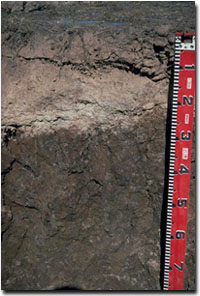 A Grey Sodosol near Chiltern. Note the presence of a bleached subsurface (A2) horizon overlying a dense and coarsely structured sodic clay subsoil - which significantly restricts root and water movement. Photograph: Mark Imhof. | |
The definition of soil sodicity has proved to be controversial (e.g. Chartres, 1993; Sumner, 1993; Sumner et al., 1998a; Rengasamy and Churchman, 1999; Levy, 2000), and a new classification scheme was proposed by Sumner et al. (1998b). Briefly, soil sodicity is assessed by the ratings of the Exchangeable Sodium Percentage (i.e. ESP) and/or the Sodium Adsorption Ratio (i.e. SAR). These two parameters are prepared and calculated in different ways (e.g. Rengasamy and Churchman, 1999) which is discussed in Assessment of Soil Sodicity. In an important paper concerned specifically with the sodicity and salinity in Australia, Northcote and Skene (1972) suggested that a soil was "sodic" if the ESP was in the range 6-14 in the top metre of a soil profile. The equivalent SAR, as measured in a 1:5 soil:water extract, was three (Rengasamy et al. 1984). Soils were considered to be "non-sodic" when the ESP was less than six and "strongly sodic" when higher than 15 (Northcote and Skene 1972). Rengasamy et al. (1984) suggested that the "non-sodic" group may be better classified as "low-sodic", considering that dispersive effects may be present.
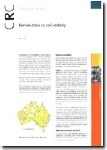 | The following two brochures were published by the Cooperative Research Centre for Soil and Land Management (Adelaide) and focus on the issue of soil sodicity/sodic soils and its/their associated problems. Permission to reproduce these brochures has been granted by the senior author, Dr P. Rengasamy. |
| Introduction to Soil Sodicity (P. Rengasamy and L. Walters) Relations between soil sodicity, salinity and soil structure are briefly outlined in this brochure. Particular emphasis has been placed on the origins, manifestations and reclamation of affected soils. Introduction to Soil Sodicity | |
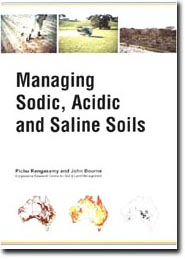 | Managing Sodic, Acidic and Saline Soils (P. Rengasamy and J. Bourne) Large areas of the Australian continent are affected by soil sodicity, salinity and acidity. The information contained in this brochure comprises a description of a field test to diagnose each of the above-mentioned problems as well as broad measures for remediation. Managing Sodic, Acid and Saline Soils prt 1 Managing Sodic, Acid and Saline Soils prt 2 Managing Sodic, Acid and Saline Soils prt 3 Managing Sodic, Acid and Saline Soils Appendix To view the information PDF requires the use of a PDF reader. This can be installed for free from the Adobe website (external link). |
Distribution of Sodic Soils in Victoria
Northcote and Skene (1972) estimated that sodic soils covered approximately 28 % of the Australian continent.
The extent of the problem is made clear by the fact that Australia has both a larger continental area of sodic soils (Rengasamy and Olsson, 1991; Bui et al., 1998; Levy, 2000) and a far higher ratio of sodic to saline soils than Africa, Asia, North and South America (Rengasamy and Olsson, 1991). Ford et al. (1993) estimated that at least 59.0 % of Victorian soils (i.e. 13.4 Mha) were sodic, which represented 73.4 % of agricultural land. With respect to dryland farming, they also calculated that 84.6 % of the cropped land and 65.9 % of that under sown pasture occurred on sodic soils.
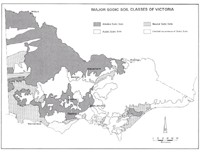 Major Sodic Soil Classes of Victoria at a scale of 1: 2 000 000 (Ford et al. 1993). © CSIRO Reproduced with permission of CSIRO PUBLISHING. http://www.publish.csiro.au/journals/ajsr/ | Using the scheme presented by Rengasamy and Olsson (1991), which related sodicity to soil pH, Ford et al. (1993) noted that alkaline sodic soils covered 37.0 % of the State and were located in the Murray Basin and west Victorian volcanic plains. Neutral sodic soils occurred in the plains to the south and west of the State and occupied 10.0 % of the land area, whilst those in the acidic sodic class were found in the central uplands and on the south coast and comprised 12.0 % of Victoria. The following map was based on an enlarged and simplified of the map produced by Northcote and Skene (1972) (see map above) and adjusted according to the classes proposed by Rengasamy and Olsson (1991). Saline sodic soils were not mapped owing to a lack of suitable data (Ford et al. 1993). |
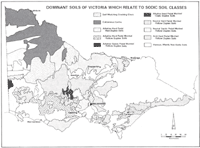 Dominant Soils of Victoria which relate to Sodic Soil Classes at a scale of 1: 2 000 000 (Ford et al. 1993). © CSIRO Reproduced with permission of CSIRO PUBLISHING. http://www.publish.csiro.au/journals/ajsr/ | The map of dominant soils as they were related to sodicity was a much simplified version of the Northcote Soil Map of Victoria in which 25 class units were reduced to 12. According to the scheme of Northcote (1979), the alkaline soils comprised red and yellow duplex soils, calcareous earths and self-mulching cracking clays whilst the neutral and acidic soil classes were predominantly yellow duplex types. A large area of red duplex soils marked to the northwest of Horsham as non-sodic has been recently reassessed as sodic by M. Imhof (pers. comm.). |
The role of soil sodicity in the classification scheme of Stace et al. (1968) was discussed by Isbell et al. (1983) and Isbell (1995). The mapping of Victorian soils using Isbell's (1996) classification scheme has yet to be completed (M. Imhof, pers. comm.).
Implications of Sodic Soils for Agriculture
An ESP of six was considered to be the lower limit of the amount of sodium required to produce a detrimental effect on the growth of most crop plants (Northcote and Skene, 1972). Other problems which can arise when the ESP is six or higher equate to the loss of soil structure by spontaneous clay dispersion, and very low rates of hydraulic conductivity (Loveday and Pyle, 1973). However, clay particles have been found to disperse spontaneously when the ESP is less than six (Boucher, 1990), especially in the presence of considerable proportions of exchangeable Mg (e.g. Emerson and Bakker, 1973). The dispersion of clay particles was also found to be strongly dependent on the electrolyte concentration in the soil solution (e.g. Quirk and Schofield, 1955; Rengasamy et al., 1984; Quirk, 2001).
Rengasamy and Churchman (1999) summarized the physical manifestations of soil sodicity as crusting, hard-setting and waterlogging of soils and the range of side effects in terms of water movement into the soil profile included reduced infiltration and plant-available water capacity, whilst reduced leaching caused perched water tables, an accumulation of toxic elements as well as increased fuel consumption during tillage, with implications for increased management costs. The impact on plants was apparent by poor seedling emergence, aeration and root development. Finally, from an environmental viewpoint, sodic soils were often associated with tunnel and gully erosion in Australia.
Further details regarding the reaction to wetting of sodic soils are being prepared for forthcoming articles in this series.
References
Anon., 1964: Physical environment: soils of Victoria. In Victorian Year Book No. 78. Commonwealth Bureau of Census and Statistics, Victorian Office, Melbourne, 1-9.
Boucher, S.C., 1990: "Field Tunnel Erosion: its Characteristics and Amelioration". Monash University, Clayton and Department of Conservation and Environment, East Melbourne.
Bui, E.N., Krogh, L., Lavado, R.S., Nachtergaele, F.O., Tóth, T. and Fitzpatrick, R.W., 1998: Distribution of sodic soils: the world scene. In Sumner, M.E. and Naidu, R. (eds) "Sodic Soils - Distribution, Properties, Management and Environmental Consequences". Oxford University Press, New York, 19-33.
Chartres, C.J., 1993: Sodic soils: an introduction to their formation and distribution in Australia. Australian Journal of Soil Research 31, 751-760.
Emerson, W.W. and Bakker, A.C., 1973: The comparative effects of exchangeable calcium, magnesium, and sodium on some physical properties of red-brown earth subsoils. II. The spontaneous dispersion of aggregates in water. Australian Journal of Soil Research 11, 151-157.
Ford, G.W., Martin, J.J., Rengasamy, P., Boucher, S.C. and Ellington, A., 1993: Soil sodicity in Victoria. Australian Journal of Soil Research 31, 869-909.
Imhof, M., Personal communication, 2001. State Chemistry Laboratory, Department of Primary Industries, Werribee, Victoria 3030.
Isbell, R.F., 1995: The use of sodicity in Australian soil classification systems. In Naidu, R., Sumner, M.E. and Rengasamy, P. (eds) "Australian Sodic Soils - Distribution, Properties and Management". CSIRO Australia, East Melbourne, 41-45.
Isbell, R.F., 1996: "The Australian Soil Classification". CSIRO Australia, Collingwood.
Isbell, R.F., Reeve, R. and Hutton, J.T., 1983: Salt and sodicity. In "Soils: an Australian Viewpoint". CSIRO Division of Soils, CSIRO, Melbourne, 107-117.
Levy, G.J., 2000: Sodicity. In Sumner, M.E. (ed. in chief). "Handbook of Soil Science". CRC Press, Boca Raton, pp. G27-63.
Loveday, J. and Pyle, J., 1973: The Emerson dispersion test and its relationship to hydraulic conductivity. CSIRO Australia, Division of Soils Technical Paper No. 15.
Naidu, R., 1993: Distribution, properties and management of sodic soils: an introduction. Australian Journal of Soil Research 31, 681-682.
Naidu, R., Sumner, M.E. and Rengasamy, P., (eds). 1995: "Australian Sodic Soils - Distribution, Properties and Management". CSIRO Australia, East Melbourne.
Northcote, K.H., 1979: "A Factual Key for the Recognition of Australian Soils". (Fourth Edition). Rellim Technical Publications, Adelaide.
Northcote, K.H. and Skene, J.K.M., 1972: "Australian soils with saline and sodic properties". CSIRO Australia, Division of Soils Soil Publication No. 27.
Quirk, J.P., 2001: The significance of the threshold and turbidity concentrations in relation to sodicity and microstructure. Australian Journal of Soil Research 39, 1185-1217.
Quirk, J.P. and Schofield, R.K., 1955: The effect of electrolyte concentration on soil permeability. Journal of Soil Science 6, 163-178.
Rengasamy, P., Greene, R.S.B., Ford, G.W. and Mehanni, A.H., 1984: Identification of dispersive behaviour and the management of Red-brown Earths. Australian Journal of Soil Research 22, 413-431.
Rengasamy, P. and Churchman, G.J., 1999: Cation exchange capacity, exchangeable cations and sodicity. In Peverill, K.I., Sparrow, L.A. and Reuter, D.J., (eds) "Soil Analysis: an Interpretation Manual". CSIRO Publishing, Collingwood, 147-157.
Rengasamy, P. and Olsson, K.A., 1991: Sodicity and soil structure. Australian Journal of Soil Research 29, 935-952.
Stace, H.C.T., Hubble, G.D., Brewer, R., Northcote, K.H., Sleeman, J.R., Mulcahy, M.J. and Hallsworth, E.G., 1968: "A Handbook of Australian Soils". Rellim Technical Publications, Glenside.
Sumner, M.E., 1993: Sodic soils: new perspectives. Australian Journal of Soil Research 31, 683-750.
Sumner, M.E., Miller, W.P., Kookana, R.S. and Hazelton, P., 1998a: Sodicity, dispersion, and environmental quality. In Sumner, M.E. and Naidu, R. (eds) "Sodic Soils - Distribution, Properties, Management and Environmental Consequences". Oxford University Press, New York, 149-172.
Sumner, M.E. and Naidu, R., (eds) 1998: "Sodic Soils - Distribution, Properties, Management and Environmental Consequences". Oxford University Press, New York.
Sumner, M.E., Rengasamy, P. and Naidu, R. 1998b: Sodic soils: a reappraisal. In Sumner, M.E. and Naidu, R. (eds) `Sodic Soils - Distribution, Properties, Management and Environmental Consequences'. Oxford University Press, New York, 3-17.
Surapaneni, A., 2001: Preface: sodicity issues in agricultural industries-current research and future directions. Australian


